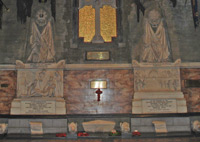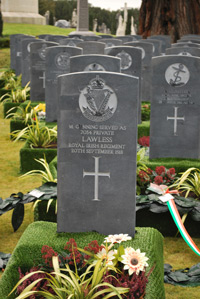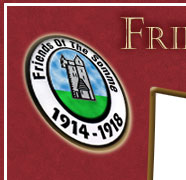 |
Forty five members from the group went to Dublin on Thursday18th November for a four day “cultural tour” in Dublin City. Our guides for the duration were father and son team , Liam and Connor Dodds. This trip came about after Connor had been invited up to Cookstown last Spring to give a talk on the Royal Dublin Fusiliers. Both Liam and Connor are experts on the involvement of the Irish Soldier in the British army, from the Boer war period and throughout the Great War. Our first visit of the tour was Trinity College where Liam gave a very detailed account of the involvement of the college and it’s occupants ( British Army officer cadet’s) during the Easter Rising in the city. We then walked to St Stephen’s Green where we saw the memorial arch to the Royal Dublin Fusiliers. After the rising this memorial was called Traitors Gate by those fighting on the side of the Rebels. The Dail was our next port of call. Here the group was allowed in to listen to the TD’S carry out their business, the Irish Language was the topic! A fully conducted tour of the Dail buildings was the finale for Thursday’s visits. |
|
|
| A fully guided tour of St Patrick’s Church of Ireland Cathedral was the first visit on Friday morning. Members saw the “Book of Remembrance” to the dead of the First World war, the recently laid wreaths at the military memorials and the “Colours” of the old Irish Regiments which were laid up in the Cathedral until they fade away. After a most interesting tour we left for our pre-arranged visit to Dublin Castle With a very enthusiastic guide we had a most wonderful tour of this amazing building and it’s contents. The Garda Museum was next on our list and again the members were thrilled with the historic collections and the stories from the curator, a serving Garda Sergeant. Kilmainham jail was the final visit for the day. The group were amazed at the history connected to this building . The guide was able to show the cells which held some very famous prisoners including those leaders of the Easter Rising who were executed by British Army firing squads. |
 |
|
|
 |
Saturday morning and our first stop was Glasnevin Cemetery. To the present there are one and a quarter burials in this cemetery. A very impressive visitors centre tells the story of this awesome cemetery and of some of the notable people buried in it’s grounds. Connor took the members on a guided tour through the cemetery showing them the various graves of British soldiers and famous participants of the Rising. Only a matter of days before we arrived the first number of Commonwealth War Grave headstones of a total of 200 had been blessed by clergy from the Roman Catholic and Anglican churches. These particular headstones had been laid out symbolically for this service on Armistice day and will soon be put in position on their respective graves in the coming weeks and months. As our guides told us ,” a sign of changing attitudes.” Collins Barracks was visited after lunch for the brilliant exhibition “Chieftains and Soldiers.” Members spent time here browsing through this very impressive story of the Irish soldier in wars throughout the world. Arbour hill where the leaders of the Easter Rising are buried and is also the National Memorial was our next stop. The final visit of the day was to the U N Veterans clubhouse to see their collections of memorabilia from their various peacekeeping campaigns throughout the world. The memorial to their dead was the final visit on Saturday. On Saturday night the group went to the workman’s club in Capel Street in which the Dublin Central Branch of the Royal British Legion meet. Here our good friend Noel Cullen welcomed the members and a great night was had by all including playing bingo and people from our group and the regulars making up for missing the X factor on TV ! Three members of the group had earlier attended the rugby International between Ireland and New Zealand. |
|
| Our last day of the trip, Sunday and our first visit was to Grangegorman Military Cemetery in Phoenix Park. In this cemetery we were able to photograph the graves of two servicemen from the Cookstown District who feature in the book “Cookstown’s War Dead.” The last grave visited here was the grave of a Dublin soldier who had been awarded a Victoria Cross and an MM in the Great War and after retuning home joined the IRA and fought against his former comrades, such is the irony of our history! The Islandbridge Memorial Park was our next stop. This park designed by Sir Edward Luytens was Irelands memorial to the dead of the two World Wars. Here we had a Service of Remembrance and David McNeil (Larne) pronounced the Exortation and Dr Foster Kelly (Magherafelt) laid the Wreath on behalf of the group. After a coffee break Connor then took us on an “ Easter Rising” tour of the city. The afternoon ended with an evening meal in our hotel and we then made our way back to Cookstown. |
 |
|


